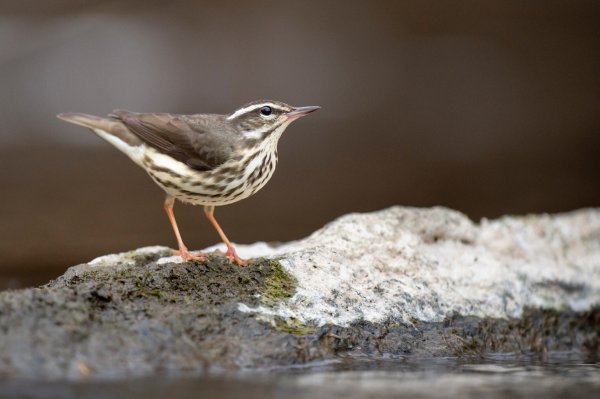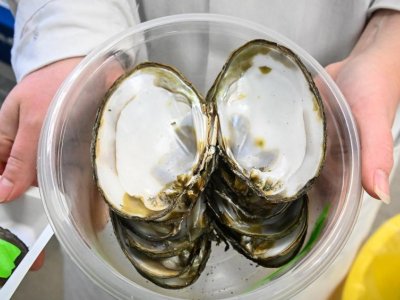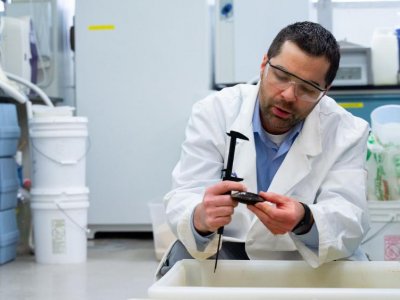
Feathers are commonly used for sampling exposure to environmental pollutants as many heavy metals and other pollutants become incorporated into the feather structure and are an indication of exposure during the time the feathers were growing. In particular, songbirds do not store calcium for egg shell production in their legs but instead need to obtain it in their diet by feeding on calcium rich items in the days preceding egg laying. Contaminants found in very high concentrations in oil and gas wastes such as barium, radium, and strontium could be important indicators of exposure because they follow and often replace calcium in biogeochemical cycles.
The Louisiana waterthrush (Parkesia motacilla) is an obligate riparian songbird that feeds primarily on benthic macroinvertebrates and may bioaccumulate contaminants through their diet. Latta et al. (2015) observed higher concentrations of barium and strontium in Louisiana waterthrush feathers collected from active areas of shale gas development compared to areas with little or no gas development suggesting the possibility that bioaccumulation of barium and strontium had occurred in areas of shale gas development. While the higher strontium and barium concentrations may indicate potential impacts from oil and gas development (OGD), distinct isotopic signatures are necessary to distinguish OGD from other possible sources of contamination.
Our goal is to establish methodology that links water quality within a watershed and subsequent bioaccumulation in a riparian bird species. We hypothesize that the element and isotopic ratios can be used to trace water contamination through the food chain. Through a collaboration with Dr. Latta, we propose to analyze the feathers collected during the Latta et al. (2015) study to determine whether the isotopic ratios (87Sr/86Sr) indicate a link between the observed bioaccumulation and OGD. Our results will show not only whether it is likely that the OGD is the source of contamination, but also demonstrate the use of 87Sr/86Sr as a new method to identify sources of contamination and track the movement of contaminants through the food chain.
Resulting Funding
- National Science Foundation “CAREER: Novel Water Quality Monitors and Indicators of Salinization (SALTSCAPES)” US National Science Foundation, Chemical, Bioengineering, Environmental, and Transport Systems (ENG/CBET) $500,000.
https://www.nsf.gov/awardsearch/showAward?AWD_ID=1942601
Resulting Publications
- Pankratz, K., & Warner, N. R. (2024). Radioactivity from oil and gas produced water accumulated in freshwater mussels. In Science of The Total Environment (Vol. 927, p. 172151). Elsevier BV. https://doi.org/10.1016/j.scitotenv.2024.172151
- Geeza, T.J., Gillikin, D.P., McDevitt, B., Van Sice, K., and Warner, N.R. (2018). Accumulation of Marcellus Formation oil and gas wastewater metals in freshwater mussel shells. Environmental Science and Technology, 52 (18) 10883-10892.
Resulting Presentations
- Warner, N.R., “The geochemical and environmental issues related to oil and natural gas production from shale and tight reservoirs” 16th International Symposium on Water-Rock Interaction and the 13th International Symposium on Applied Isotope Geochemistry, Tomsk, Russia. July 21-July 26, 2019.
- Warner, N.R., Geeza, T.J., and Gillikin, D. “Accumulation of oil and gas wastewater contaminants in freshwater bivalves” American Geophysical Union. Washington, DC. December 10-14, 2018.
- Warner, N.R. “Shells and sediment as records of oil and gas wastewater discharges” Pennsylvania State University Geosciences Colloquium. University Park, PA. October 26, 2018.
- Warner, N.R., McDevitt, B. , Geeza, T.J. , Van Sice, K., and Gillikin, D. “Strontium, barium, and radium as tracers of oil and gas contaminant accumulation in biota and sediment” Goldschmidt Conference. Boston, MA. August, 14, 2018.
- Warner, N.R., S. Latta, M. Brittingham, M. Fantle, Geeza, T.J. , McDevitt, B. , Hazy, Soler, Y. “Strontium isotope ratios in riparian bird feathers as indicators of shale gas development” Ecological Society of America. New Orleans Louisiana. August 8, 2018.
- Warner, N.R. “Drilling, waste, treatment constraints or opportunities” The Seneca Nation of Indians 2nd Intergovernmental Environmental Policy Meeting. Salamanca, NY. July 25, 2018.
- Warner, N.R., Latta, S., Brittingham, M., Fantle, M., Geeza, T.J. , McDevitt, B. , Van Sice, K. , Hazy, R., Soler Y. “Bioaccumulation of alkali earth metals associated with oil and gas operations” Shale Network Workshop. University Park, PA. May 18, 2018.
- Warner, N.R. “Impacts on water quality from oil and gas wastewater management” Duke University Earth and Ocean Sciences Seminar Series. Durham, NC. December, 1, 2017.
- Warner, N.R., Hazy, R., Geeza, T.J. , and Gillikin, D. “Investigating bioaccumulation of alkaline earth metals associated with oil and gas operations” 254th American Chemical Society. Washington, DC. August 20-24, 2017.
Researchers
Margaret Brittingham

Steven C. Latta









